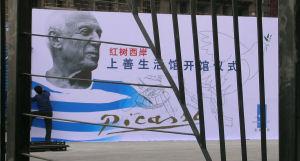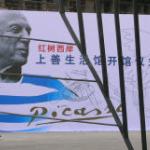Searching for Pablo
A tale of art and conspicuous consumption in China's Booming-est City
It was the sort of gig that any freelance features writer with a knack for chatting up China's art-scene hipsters would jump at: a large collection of paintings and sketches by Pablo Picasso had come to China, and were beginning a multi-city tour in Shenzhen. The pieces in question had never before been seen in Asia, and were naturally priceless. The Xinhua report released on November 25, though lacking in details, was tantalizing: "265 never before seen in Asia Picasso originals, plates, prints and watercolor paintings...invaluable collection on loan from France's Picasso Foundation currently on VIP display in Shenzhen."
That all parties involved would be eager to promote the event seemed a given. But in China, things of any great magnitude are rarely so simple, and in tracking down what should have been basic facts germane to Hong Kong art lovers, I found myself on a strange and twisted path which led not into the world of art but into that of high priced real estate.
Locating the art proved difficult. The sudden appearance of 265 Picasso originals in any city is a big cause d'affaire, so it stood to reason that the curator of Shenzhen's highly respected He Xiangning Art Museum would know of the art's whereabouts. However, after several rounds of communication, HXM curator Liu Yingjiu was able only to confirm that while the Picassos were on display somewhere in Shenzhen, he was still out of the loop. Rather than being kept with the museum or at some tightly guarded government location, the work was instead being displayed privately in a newly built real estate development called the Mangrove West Coast. And while they would eventually be moved to his museum for public display, he had yet to secure his own invitation to the VIP display alluded to in the Xinhua story.
It seemed odd that the curator of Shenzhen's most prestigious art museum wasn't considered VIP enough to warrant an invite. A call to the French cultural attaché in Hong Kong was similarly fruitless. With nothing more to go on than an insubstantial Xinhua story and vague rumors, I headed to Shenzhen's He Xiangning Museum, figuring that visiting the place where the art was slated to wind up later in the month was my best lead. Mr. Liu was good enough to tell me a bit about how these priceless works came to be in China, but as for getting me any closer to the art itself he said I'd have to come back later in the month.
'We were approached to host the Picasso exhibit, but our contact was with an advertising company in Beijing. This company, it seemed, had obtained the right to show paintings in Shenzhen, and as the Mangrove sponsored the trip, they are first using the art to impress their customers. The pieces will come to our museum for public viewing on Dec 26th, and stay here until January 23rd before moving on to Shanghai.'
As he spoke of the role of art in China's newest and richest city, the pieces began falling into place.
'As far as I see, there's a tendency to see art appropriated by the new elite. I don't know if this makes us more appreciative of art...though art consumption is certainly flourishing here.'
With neither official invitation nor press credentials, I hopped into a taxi and headed over to the Mangrove West Coast development. It was there, on the outside of a group of semi-finished luxury high rises not far from Shenzhen's Shekou district, that I finally found Pablo Picasso - or at least his image, standing twelve feet high behind the iron bars separating the development from the street. His face was on a billboard, looking out wistfully in angled profile over Chinese characters touting the benefits of life at the Mangrove West Coast. Also present was the signature Picasso dove, the same one which once graced a Chinese postage stamp in the years following the revolution. Only now the dove flew not over a flag but a company logo.
Within moments, a guard approached me and asked if I was on the guest list. With nothing to lose, I said maybe, and handed him my business card with both hands and gravitas. 'Wait here' he said, heading back behind the gates 'I will tell the management that you've arrived.
And ten minutes later, perhaps owing to what Horiatio Alger called luck and pluck, I was being led through the front gate and into the heart of the ultra swank development by a sharply dressed sales representative named Nicko. At last, I thought, art appreciation begins.
But not quite yet; after relinquishing camera and cell phone with the security guards (picture taking is not permitted), I was shunted into a small auditorium with plush couches and a huge curved monitor to view a slick videotaped presentation. The subject of the film was not Picasso, but la dolce vita, Mangrove West Coast style. As images of shining, happy urbanites drifted across the screen, a soothing voice spoke effusively of the complex in putonghua.
I emerged from the darkened auditorium with all thoughts of Picasso gone, replaced by visions of myself leading an upwardly-mobile urban lifestyle with all the mod-cons in a complex that's (according to the promotional material) 'shaped like a windmill to create a dynamic symphony of sound.'
My fantasies were abruptly interrupted.
'Come this way, I want to show you something.' Nicko guided me over to a massive circular wall with framed pictures set behind thick glass, and I momentarily remembered why I'd come. Art...yes...truth and beauty...
But behind the glass wasn't Picasso, but charts and graphs pertaining to design and architecture. Nicko handed me an MP3 player and instructed me to press the number corresponding to each section of the exhibit. In dreamy Putonghua I learned that the floors of the buildings were constructed with a multi-layered design that made them virtually soundproof and that the windows were made from a space age vibration-proof glass that allowed for full diffusion of light and zero transmission of sound. 20 minutes into my tour and Picasso was nowhere to be seen, but no matter; I was sold. When could I move in?
Nicko interrupted my fantasies of bourgeois urban splendor. 'Now we can go and see the Picassos.' Together we took a silent glass elevator up to the third floor, an oval-shaped room just big enough to conduct a spirited yoga class for 35 students. Set up in the room were four felt-lined partitioning walls, and on these walls were hung, with the greatest of care, possibly the most valuable collection of artwork ever seen in Shenzhen. Six armed guards stood at attention along the walls, and a sign in English and Chinese admonished visitors that the works contained within this room were to be neither touched nor photographed.
I made my way clockwise around the makeshift gallery with my sales rep-cum-art curator by my side, pausing to gaze reverently at the timeless works on the third floor while two floors below an equally large display described the benefits of polymer sheet rock. The works were indeed exquisite, encompassing various periods in the artist's creative life. Les Tricornes, watercolors from 1920 drawn for a production of the same name, the deceptively simple line drawings from his 1949 Garmen collection, the very un-cubist naturalist works of 1942's Histoire Naturelle, and the sensual, decidedly cubist sketches of 1968's La Celestina. I found myself wondering how the concept of connecting the works of Picasso and this real estate development came to be. Before I'd even asked, Nicko answered.
'Look at the diversity! Picasso, you see, was an artist not merely of exceptional talent, but also of many different styles. Some people may not like one style or the other, but anybody could find among the vast body of Picasso's work a style to match their own tastes. This matches perfectly our philosophy of diversity at Mangrove West Coast; every unit custom fit to suit the styles of individual buyers.'
I had to admit then and there that I was indeed duly impressed.
I wanted to spend an hour or so appreciating these magnificent works, but something about the atmosphere suggested that dallying for any great length of time would be considered gauche. Besides, we had yet to reach the climax of the presentation - a group tour of a fully equipped model Mangrove West Coast unit.
Nicko brought me downstairs to the second floor for tea and biscuits (imported from Italy). On leather divans on either side of us, young, smartly dressed couples sat discussing the benefits of Mangrove life with their respective sales reps. After ten minutes, we joined another group and were ushered en-masse into the display unit. I forgot all about art as the staff of the Mangrove introduced a higher beauty; that of a fully equipped, climate controlled luxury housing unit with floor to ceiling windows and ocean views. This was where I wanted to live out my urban dreams: the locks to the front door were biometric, and would open only for those whose fingerprints had been programmed in. Every electronic item in the apartment, including the window blinds, were accessible via a centrally located tablet PC, and could be programmed to operate on a timer. The refrigerator contained a flat-screen monitor that was internet ready and doubled as a doodle-pad for the kids. The toilet seats were heated.
There was no hard sell being employed here; people who can afford to buy property in the Mangrove weren't the types who responded to pressure, and besides, these units practically sold themselves.
As the group was being herded out of the unit, I asked Nicko about the Picassos. After all, the whole exhibit was on short term loan from the French Government, and would soon be turned over to the He Xiangning museum for public viewing. Would Mangrove West management be purchasing other priceless works of art for display in the third floor gallery?
'Actually,' he admitted 'when all the units are sold, we will be turning the third floor into a kindergarten for the resident's children.'
I collected my phone and camera, and Nicko led me back out the front gate and waited with me until a taxi came by. As the Mangrove West Coast disappeared behind me, I reflected on the bizarre twist that my search for Picasso had taken, and on the appropriateness of using the works and image of a world renowned artist and lifelong communist to sell homes that only the ultra-rich could even dream of owning. It seemed conspicuously incongruous, like a stock broker using quotes from Chairman Mao in a sales pitch. But Deng Xiaoping said 'to get rich is glorious,' and Shenzhen is Deng's town. And who knows? Picasso was a fan of bizarre juxtaposition. Maybe he'd get a chuckle out of the whole scene. Perhaps the great artist would even become so enamored with his new apartment's electronic refrigerator-mounted doodle pad that he'd simply trade his egalitarian sensibilities for bourgeois decadence, adding his prodigious talents to those of China's new elite, marching headlong into a glorious future of perfect luxury for the select few.
* * *
Originally run in Hong Kong's South China Morning Post, December 19, 2004
* * * * *
 ThingsAsian
ThingsAsian

















